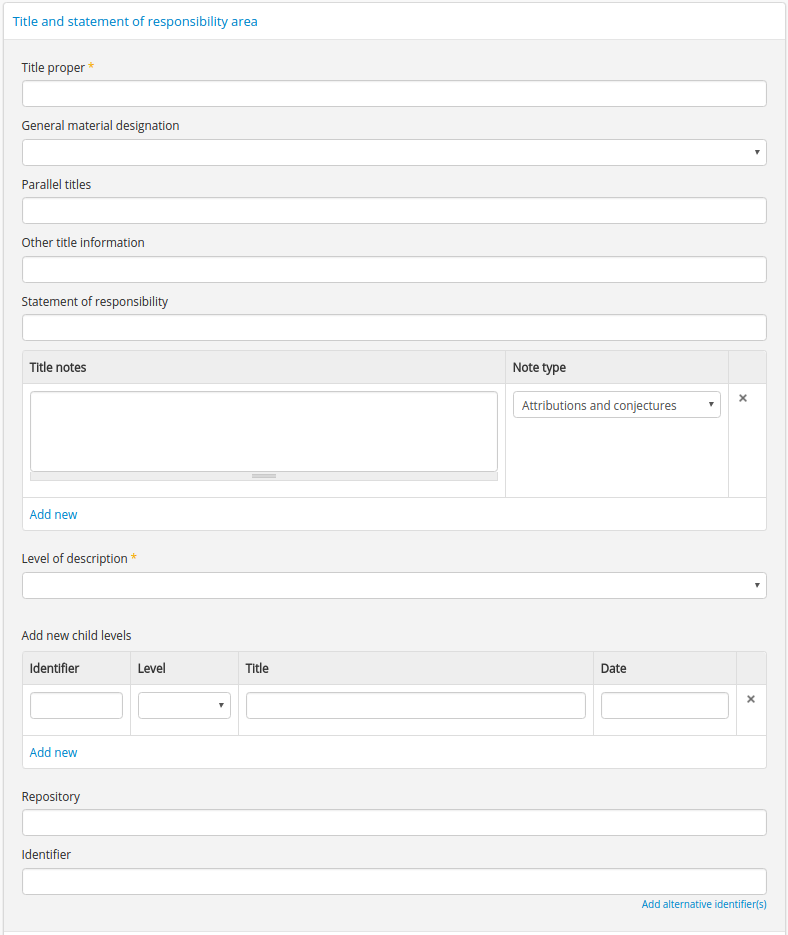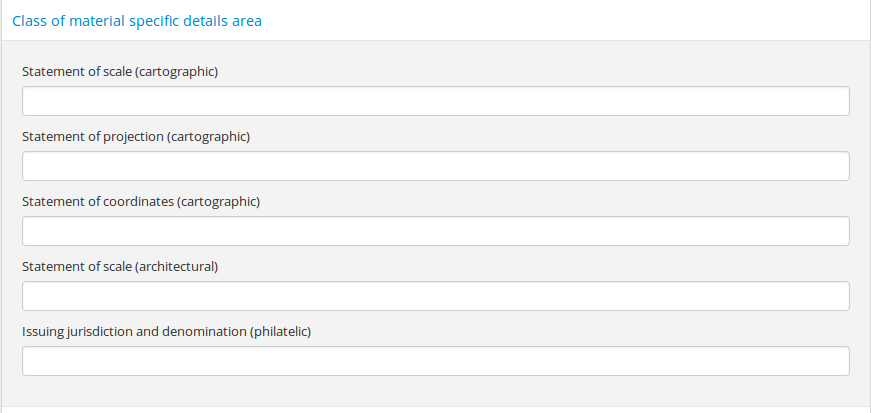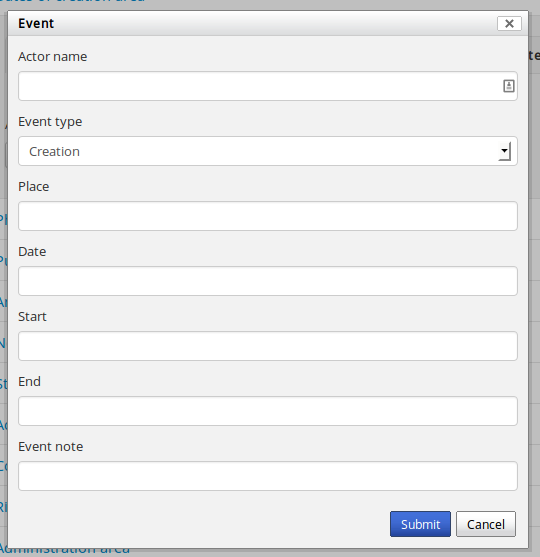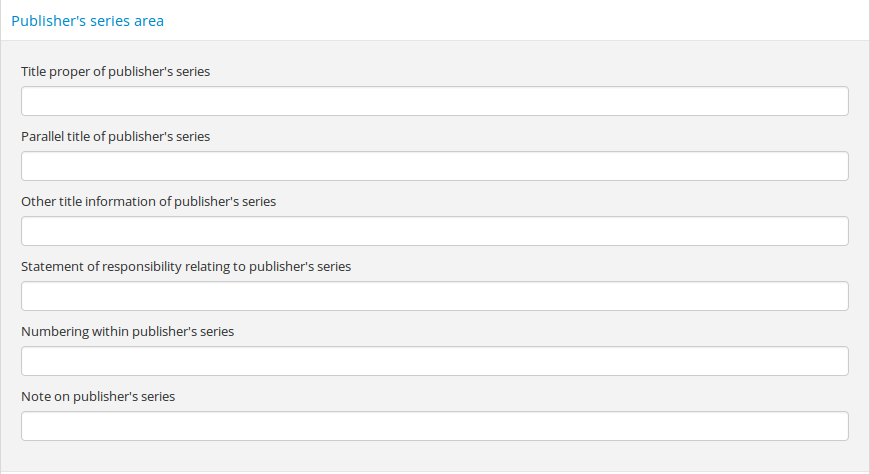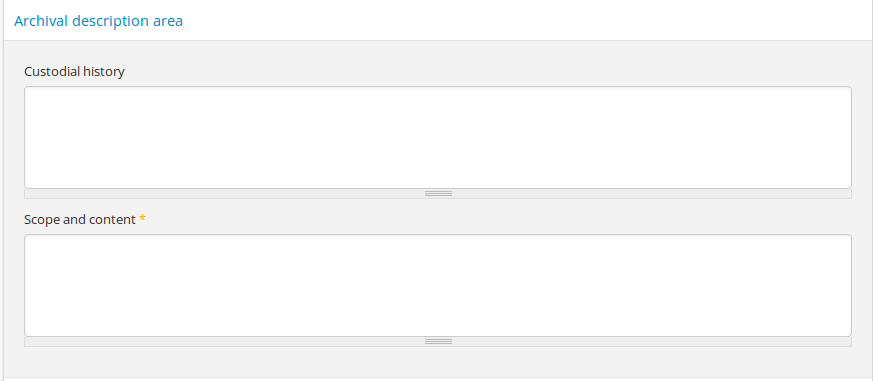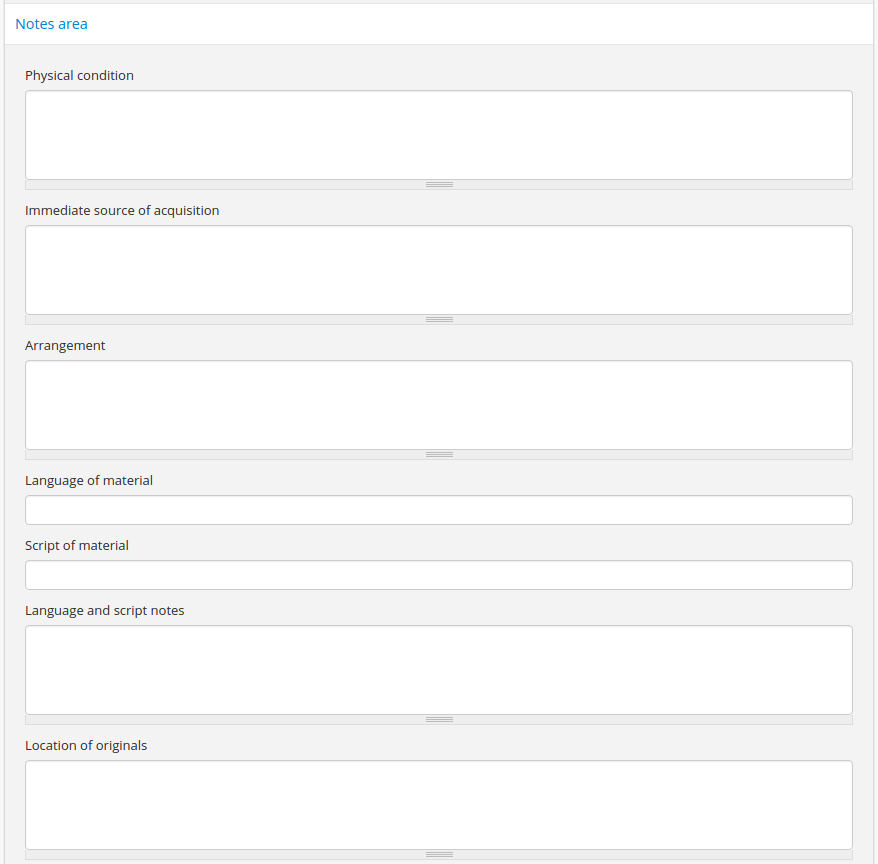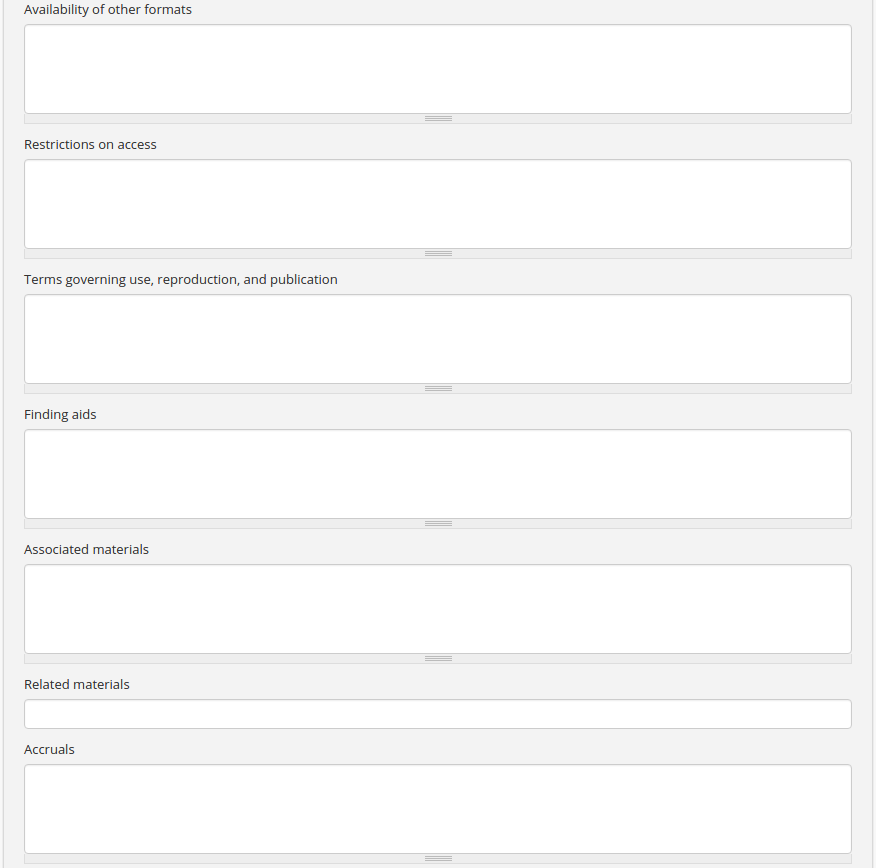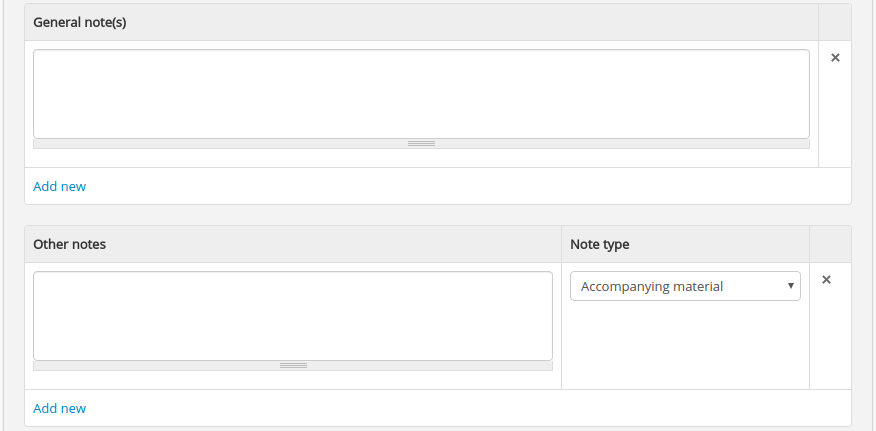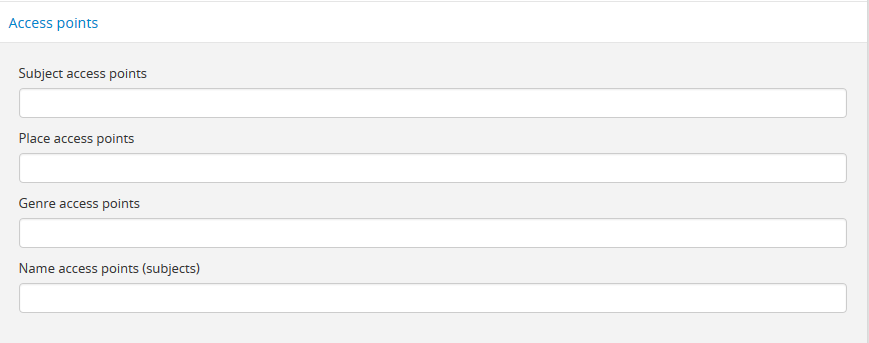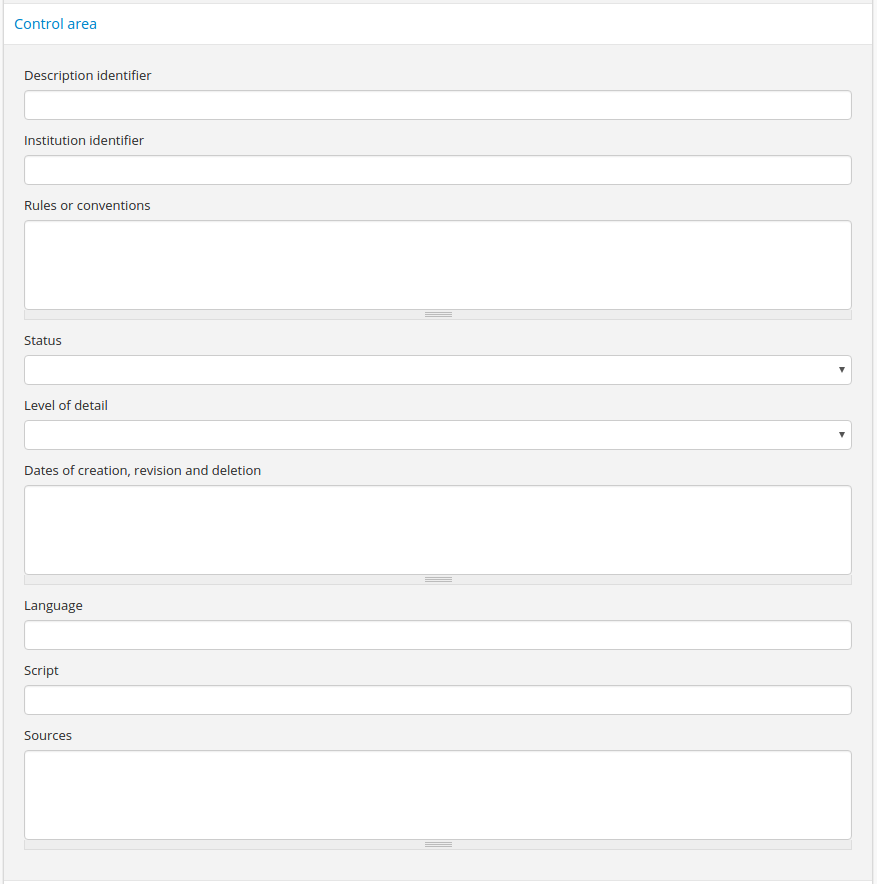Rules for Archival Description (RAD) data entry and CSV template¶
On this page you will find:
- Link to downloadable CSV template using Rules for Archival Description
- Description of fields used when entering or importing archival descriptions using Rules for Archival Description in a CSV file or entering the data manually.
See also
RAD CSV template¶
To download the Rules for Archival Description CSV template for AtoM, please visit our wiki page:
Field descriptions¶
RAD is maintained by the Canadian Council of Archives and is available at http://www.cdncouncilarchives.ca/archdesrules.html.
Information below includes:
- Template field refers to the default label for that field in AtoM
- CSV Column refers to the title of the column in the CSV template
- RAD Rule refers to the rule from the applicable standard and/or the instructions provided by AtoM.
- EAD refers to the field mapping to EAD
- Notes includes any other information needed for successful data entry or CSV import.
Skip to:
- Title and statement of responsibility area
- Edition area
- Class of material specific details area
- Authority record fields
- Dates of creation area
- Physical description area
- Publisher’s series area
- Archival description area
- Notes area
- Standard number area
- Access points
- Control area
- Rights area
- Administration area
Title and statement of responsibility area¶
Title proper¶
Template field Title proper
CSV Column title
RAD Rule Enter the title proper, either transcribed or supplied (RAD 1.1B)
EAD
At a parent level:
<archdesc level="[name of level]">
<did>
<unittitle encodinganalog="1.1B">
At a child level:
<c level="[name of level]">
<did>
<unittitle encodinganalog="1.1B">
Note
The EAD tag <titleproper encodinganalog="title"> refers to the
title of the finding aid, not the archival description.
General material designation¶
Template field General material designation
CSV Column radGeneralMaterialDesignation
RAD Rule Select the General Material Designation at the highest level of description. If there are more than three, select “multiple media.” (RAD 1.1C)
EAD
<archdesc>
<controlaccess>
<genreform source="rad" encodinganalog="1.1C">
Note
Although the RAD standard specifies set values for General Material
Designations, in AtoM these can be edited in the Material type
taxonomy (see: Add a new term). As of 2.2, the RAD
template also has a separate Genre taxonomy, which uses the <genreform>
EAD element as well, but without the @source and @encodinganalog
attributes.
Parallel title¶
Template field Parallel title
CSV Column alternateTitle
RAD Rule [W]hen applicable, transcribe parallel titles that appear in conjunction with the formal title proper…(RAD 1.1D)
EAD
<did>
<unittitle type="parallel" encodinganalog="1.1D">
Other title information¶
Template field Other title information
CSV Column radOtherTitleInformation
RAD Rule Transcribe other title information that appears in conjunction with the formal title proper. (RAD 1.1E)
EAD
<did>
<unittitle type="otherInfo" encodinganalog="1.1E">
Title statement of responsibility¶
Template field Statements of responsibility
CSV Column radTitleStatementOfResponsibility
RAD Rule “At the item level of description, transcribe explicit statements of responsibility appearing in conjunction with the formal title proper in or on the chief source of information…” (RAD 1.1F)
EAD
<did>
<unittitle type="statRep" encodinganalog="1.1F">
Title notes - Statements of responsibility¶
Template field Title notes- Statements of responsibility
CSV Column radTitleStatementOfResponsibilityNote
RAD Rule “Make notes on any statement(s) of responsibility that appear outside the chief source of information or that appear on the chief source, but not in conjunction with a formal title proper. Record statements of responsibility that appear on the chief source of information for a file or series, if applicable.” (RAD 1.8B5)
EAD
<odd type="titleStatRep" encodinganalog="1.8B5"><p>
Title notes - Attributions and conjectures¶
Template field Title notes- Attributions and conjectures
CSV Column radTitleAttributionsAndConjectures
RAD Rule “Make notes on authors to whom the unit being described has been attributed, and cite sources, if appropriate.” (RAD 1.8B6)
EAD
<odd type="titleAttributions" encodinganalog="1.8B6><p>
Title notes - Continuation of title¶
Template field Title notes- Continuation of title
CSV Column radTitleContinues
RAD Rule “Complete the transcription if the formal title proper and/or other title information was abridged in the description.” (RAD 1.8B4)
EAD
<odd type="titleContinuation" encodinganalog="1.8B4><p>
Title notes - Source of title proper¶
Template field Title notes- Source of title proper
CSV Column radTitleSourceOfTitleProper
RAD Rule “Indicate the source of a title proper, when appropriate.” (RAD 1.8B2)
EAD
<odd type="titleSource" encodinganalog="1.8B2"><p>
Title notes - Variations in title¶
Template field Title notes- Variations in title
CSV Column radTitleVariationsInTitle
RAD Rule “Make notes on variant titles appearing outside the prescribed source of information. Make notes on titles by which the unit being described has been traditionally known other than the title proper.” (RAD 1.8B1)
EAD
<odd type="titleVariation" encodinganalog="1.8B1"><p>
Title notes - Parallel titles and other title information¶
Template field Title notes- Parallel titles and other title information
CSV Column radTitleParallelTitles
RAD Rule “Make notes on parallel titles and other title information not recorded in the Title and statement of responsibility area if they are considered to be important.” (RAD 1.8B3)
EAD
<odd type="titleParallel" encodinganalog="1.8B3"><p>
Level of description¶
Template field Level of description
CSV Column levelOfDescription
RAD Rule Select a level of description from the drop-down menu. See RAD 1.0A for rules and conventions on selecting levels of description.
EAD
At the parent level:
<archdesc level="fonds" relatedencoding="RAD">
At the child level:
<dsc type="combined">
<c level="[name of level]">
Note
An administrator can edit the values in the Levels of description taxonomy (see: Add a new term). In CSV import, if a term is used that is not already in the taxonomy, it will be added to the Levels of description taxonomy.
Add new child levels¶
Template field Identifier, Level, Title, Date
CSV Column See notes below
RAD Rule Identifier: Enter an unambiguous code used to uniquely identify the description.
Level: Select a level of description from the drop-down menu. See RAD 1.0A for rules and conventions on selecting levels of description.
Title: Enter the title proper, either transcribed or supplied (RAD 1.1B).
Date: (Works similarly to the display date field when adding a date of creation; see below for more information in RAD)
EAD N/A (see the related fields elsewhere in this page)
Note
This widget has been added to help improve workflows when creating new descriptions via the user interface. When entering descriptions manually, users can add new child records in this area while creating a parent record.
The dates field corresponds to a date of creation - if you would like a different kind of date, you will have to either navigate to the child description after saving the new parent record, and change the date type, or simply ignore the date field in the widget, and add the correct date type manually to the child record after saving the new parent record.
In CSV import, adding child records can be achieved using the legacyID and parentID columns. See Legacy ID mapping: dealing with hierarchical data in a CSV.
Repository¶
Template field Repository
CSV Column repository
RAD Rule Select the repository that has custody and control of the archival material. The values in this field are drawn from the Authorized form of name field in archival institution records. Search for an existing name by typing the first few characters of the name. Alternatively, type a new name to create and link to a new archival institution.
EAD
<archdesc>
<did>
<repository>
<corpname>
Note
When an address is included in the related archival institution (i.e.
added to the Contact area of the linked repository record), the address will
also appear in the EAD at the parent level. Because EAD does not include
attributes for the <addressline> element, these will not roundtrip properly
when exported from one AtoM instance and into another - all the information
will appear in one field of the Contact area upon re-import. Below is an
example of the EAD with an address included:
<repository>
<corpname>Artefactual Archives</corpname>
<address>
<addressline>Suite 201 – 301 6th Street</addressline>
<addressline>New Westminster</addressline>
<addressline>British Columbia</addressline>
<addressline>Canada</addressline>
<addressline>Telephone: (604)527-2056</addressline>
<addressline>Email: info@artefactual.com</addressline>
<addressline>http://www.artefactual.com</addressline>
</address>
</repository>
Important
When linking an archival institution to an archival description, You should only link at the highest level of description. AtoM will automatically inherit the repository name at lower levels. This conforms to RAD’s General Rule 1.0A2d Non-repetition of information: “Do not repeat information at a lower level of description that has already been given at a higher level….” Linking a repository at all levels of description (instead of just at the parent level) in a large hierarchy can also impact performance.
Reference code¶
Template field Identifier
CSV Column identifier
RAD Rule Enter an unambiguous code used to uniquely identify the description.
EAD
<did>
<unitid encodinganalog="1.8B11" countrycode="[2 letter country code]">
Note
This field displays to non-logged in users as “Reference code.”
While editing the record, the full reference code including any identifiers
inherited from higher levels will appear
below the Identifier field. The @countrycode value is taken from the
Country value entered into the Contact area of the related repository.
Alternative identifier¶
Template field Add alternative identifier(s) [link beneath identifier field]
CSV Columns alternativeIdentifiers and alternativeIdentifierLabels
RAD Rule N/A (see note below)
EAD
<did>
<unitid type="alternative" label="[user entered value]">
Note
The use of the alternative identifier fields is documented in full here:
In the CSV templates, the columns can accept multiple values, separated by a
pipe | character. The label values will be matched 1:1 with the
identifiers.
Edition area¶
Edition statement¶
Template field Edition statement
CSV Column radEdition
RAD Rule “Transcribe the edition statement relating to the item being described.” (RAD 1.2B1) “If the item being described lacks an edition statement but is known to contain significant changes from other editions, supply a suitable brief statement in the language and script of the title proper and enclose it in square brackets.” (RAD 1.2B3)
EAD
<did>
<unittitle type="editionStat" encodinganalog="1.2B1">
<edition>
Note
This field also maps to the <editionstmt><edition> tag in
<eadheader><filedesc>.
Edition statement of responsibility¶
Template field Edition statement of responsibility
CSV Column radEditionStatementOfResponsibility
RAD Rule “Transcribe a statement of responsibility relating to one or more editions, but not to all editions, of the item being described following the edition statement if there is one.” (RAD 1.2.C1) “When describing the first edition, give all statements of responsibility in the Title and statement of responsibility area.” (RAD 1.2C2)
EAD
<did>
<unittitle type="statRep" encodinganalog="1.2C">
<edition>
Class of materials specific details area¶
RAD: “1.3A. Preliminary rule: 1.3A1. Scope: For instructions regarding this area, refer to the chapters dealing with the class(es) of material that use it.”
Statement of scale (cartographic)¶
Template field Statement of scale (cartographic)
CSV Column radStatementOfScaleCartographic
RAD Rule “Give the scale of the unit being described…as a representative fraction (RF) expressed as a ratio (1: ). Precede the ratio by Scale. Give the scale even if it is already recorded as part of the title proper or other title information.” (RAD 5.3B1)
EAD
<did>
<materialspec type="cartographic" encodinganalog="5.3B1">
Statement of projection (cartographic)¶
Template field Statement of projection (cartographic)
CSV Column radStatementOfProjection
RAD Rule “Give the statement of projection if it is found on the prescribed source(s) of information.” (RAD 5.3C1)
EAD
<did>
<materialspec type="projection" encodinganalog="5.3C1">
Statement of coordinates (cartographic)¶
Template field Statement of coordinates (cartographic)
CSV Column radStatementOfCoordinates
RAD Rule “At the fonds, series or file levels, record coordinates for the maximum coverage provided by the materials in the unit, as long as they are reasonably contiguous.” (RAD 5.3D)
EAD
<did>
<materialspec type="coordinates" encodinganalog="5.3D">
Statement of scale (architectural)¶
Template field Statement of scale (architectural)
CSV Column radStatementOfScaleArchitectural
RAD Rule “Give in English the scale in the units of measure found on the unit being described. If there is no English equivalent for the name of the unit of measure, give the name, within quotation marks, as found on the unit being described.” (RAD 6.3B)
EAD
<did>
<materialspec type="architectural" encodinganalog="6.3B">
Issuing jurisdiction and denomination (philatelic)¶
Template field Issuing jurisdiction and denomination (philatelic)
CSV Column radIssuingJurisdiction
RAD Rule “Give the name of the jurisdiction (e.g., government) responsible for issuing the philatelic records.” (RAD 12.3B1) “For all units possessing a denomination (e.g., postage stamps, revenue stamps, postal stationery items), give the denomination in a standardized format, recording the denomination number in arabic numerals followed by the name of the currency unit. Include a denomination statement even if the denomination is already recorded as part of the title proper or other title information.” (RAD 12.3C1)
EAD
<did>
<materialspec type="philatelic" encodinganalog="12.3B1">
Authority record fields¶
These fields are found in the CSV template but when entering descriptions manually are found in the authority record. However, the description can be linked to the authority record while entering the data manually.
Creator¶
Template field Creator
CSV Column eventActors
RAD Rule Use the Actor name field to link an authority record to this description. Search for an existing name in the authority records by typing the first few characters of the name. Alternatively, type a new name to create and link to a new authority record.
EAD
<origination encodinganalog="1.4D">
<name>
Note
This is the default export EAD when an Entity type has not been set for the
actor on the related authority record. The final EAD element can be
more precise, if the user has entered an Entity type on the related
authority record. When the Entity type is set to Person, the EAD
will export using <persname> instead of <name>; when set to
Family, the EAD will export using <famname> instead of <name>;
and when set to Organization, the EAD will export using <corpname>
instead of <name>. The <name> element is the default when no
entity type is set. For more information on authority records and the ISAAR
standard upon which the authority record template is based, see:
Authority records and International Standard Archival Authority Record for Corporate Bodies, Persons, and Families.
Note
In the CSV template, this column can accept multiple values, separated by a
pipe | character. The label values will be matched 1:1 with the identifiers.
Tip
When entering the description manually, the Creator field is found in the RAD template within the Dates of creation information area, labeled as “Actor name.”
Important
When linking a creator to an archival description, you should only link at the highest level of description. AtoM will automatically inherit the creator name at lower levels. This conforms to RAD’s General Rule 1.0A2d Non-repetition of information: “Do not repeat information at a lower level of description that has already been given at a higher level….” Linking a repository at all levels of description (instead of just at the parent level) in a large hierarchy can also impact performance.
Biographical history¶
Template field Biographical history
CSV Column eventActorHistories
RAD Rule “Record in narrative form or as a chronology the main life events, activities, achievements and/or roles of the entity being described. This may include information on gender, nationality, family and religious or political affiliations. Wherever possible, supply dates as an integral component of the narrative description.” (ISAAR 5.2.2)
See also RAD section 1.7B1.
EAD
<bioghist id="[md5 hash]" encodinganalog="1.7B">
<note>
<p>
Note
When entering data manually, this field needs to be written in the authority record. If an authority record does not already exist, AtoM will create one when a new creator is entered, above. The user can then navigate to the authority record to enter the Biographical or Administrative history (see: Authority records).
Note
When importing descriptions by CSV, by default this column will create a Biographical history in the authority record, regardless of whether the creator is a person, family, or organization. To specify the entity type when importing creators, users would need to import authority records or manually edit the authority record.
In the CSV template, this column can accept multiple values, separated by a
pipe | character. The label values will be matched 1:1 with the identifiers.
Note
When roundtripping descriptions from one AtoM instance to another, creator
names in the <origination> element are matched 1:1 in order with
administrative or biographical histories included in <bioghist>. It is
therefore important that if some creators do not have related histories, they
appear in the EAD after those that do, so the 1:1 mapping can work as
expected. If an extra <bioghist> element is included that does not have
a corresponding creator name, a stub authority record will be created
to hold the <bioghist> data.
Dates of creation area¶
When entering data manually, the fields below are accessed by clicking “Add new” in the dates of creation area.
Entering an actor’s name will automatically insert the actor’s biographical sketch or administrative history from the authority record.
When entering data manually, users can choose an event type from a drop-down menu. The event types can be edited by an administrator in the Event types taxonomy (see: Add a new term). When importing descriptions via CSV, the event type defaults to Creation.
Place¶
Template field Place
CSV Column N/A
RAD Rule “For an item, transcribe the place of publication, distribution, etc., in the form and grammatical case in which it appears.” (RAD 1.4C1). Search for an existing term in the places taxonomy by typing the first few characters of the term name. Alternatively, type a new term to create and link to a new place term.
EAD
<controlaccess>
<geogname role="Creator" encodinganalog="1.4C" id="atom_200823_place">
Note
The above example assumes that the place was linked to a creator, as opposed
to a publisher, broadcaster, or other role - the @role attribute value
will depend on the type of event entered. An example @id is included
in this example as well - atom will generate and use these to maintain the
relationship between a creator name, date, and place when roundtripping.
Date(s)¶
Template field Date
CSV Column eventDates and eventTypes
RAD Rule “Give the date(s) of creation of the unit being described either as a single date, or range of dates (for inclusive dates and/or predominant dates). Always give the inclusive dates. When providing predominant dates, specify them as such, preceded by the word predominant…” (1.4B2). Record probable and uncertain dates in square brackets, using the conventions described in RAD 1.4B5.
EAD (creator example)
<did>
<unitdate id="[atom-generated-value]" normal="[start date/end date]" encodinganalog="1.4B2">
Note
The CSV column in earlier versions prior to 2.2 was named “creatorDates” - it has been updated to clarify its relation to the creation event - not to the dates of existence of the creator. However, we have added fallback code, so if the old name is used, the import will still succeed.
Note
This field will display the date as intended by the editor of the
archival description, in the language of the standard being used. The start
and end date values, which must be ISO-formatted (YYYY-MM-DD), will populate
the @normal attribute. AtoM will also generate an ID to be able to link
the creator name, place, and event date again when roundtripping from one
AtoM instance to another.
Users can also set the type of event, using the “Event type” drop-down menu. In the RAD edit page, the default terms in the drop-down menu for “Event type” are:
- Creation
- Custody
- Publication
- Contribution
- Collection
- Accumulation
- Reproduction
- Distribution
- Broadcasting
- Manufacturing
AtoM will also add a @datechar attribute for different types of events. Here
is an example for a broadcasting event date in EAD XML:
<did>
<unitdate id="[atom-generated-value]" datechar="broadcasting" normal="[start date/end date]" encodinganalog="1.4F">
Dates of creation - Start¶
Template field Start
CSV Column eventStartDates
Note
The CSV column in earlier versions prior to 2.2 was named “creatorDatesStart” - it has been updated to clarify its relation to the creation event - not to the dates of existence of the creator. However, we have added fallback code, so if the old name is used, the import will still succeed.
RAD Rule Enter the start year. Do not use any qualifiers or typographical symbols to express uncertainty. Acceptable date formats: YYYYMMDD, YYYY-MM-DD, YYYY-MM, YYYY.
EAD
<did>
<unitdate id="[atom-generated-value]" normal="[start date/end date]" encodinganalog="1.4B2">
Note
This field only displays while editing the description. If AtoM is
able to interpret the start date from the Date(s) field, above, it will
autopopulate upon entering. In the EAD, the start and end date values are added
to the @normal attribute of the corresponding <unitdate> element.
Dates of creation - End¶
Template field Dates of creation - End
CSV Column eventEndDates
RAD Rule Enter the end year. Do not use any qualifiers or typographical symbols to express uncertainty. Acceptable date formats: YYYYMMDD, YYYY-MM-DD, YYYY-MM, YYYY.
EAD
<did>
<unitdate id="[atom-generated-value]" normal="[start date/end date]" encodinganalog="1.4B2">
Note
The CSV column in earlier versions prior to 2.2 was named “creatorDatesEnd” - it has been updated to clarify its relation to the creation event - not to the dates of existence of the creator. However, we have added fallback code, so if the old name is used, the import will still succeed.
Note
This field only displays while editing the description. If AtoM is
able to interpret the start date from the Date(s) field, above, it will
autopopulate upon entering.In the EAD, the start and end date values are added
to the @normal attribute of the corresponding <unitdate> element.
Dates of creation - Note¶
Template field Event Note
CSV Column eventDescriptions
RAD Rule “Make notes on dates and any details pertaining to the dates of creation, publication, or distribution, of the unit being described that are not included in the Date(s) of creation, including publication, distribution, etc., area and that are considered to be important. ” (RAD 1.8B8) “Make notes on the date(s) of accumulation or collection of the unit being described.” RAD 1.8B8a)
Note
The CSV column in earlier versions prior to 2.2 was named “creatorDatesNotes” - it has been updated to clarify its relation to the creation event - not to the dates of existence of the creator. However, we have added fallback code, so if the old name is used, the import will still succeed.
Note
This field appears while editing as “Event note.”
EAD N/A
Physical description area¶
Physical description¶
Template field Physical description
CSV Column extentAndMedium
RAD Rule “At all levels record the extent of the unit being described by giving the number of physical units in arabic numerals and the specific material designation as instructed in subrule .5B in the chapter(s) dealing with the broad class(es) of material to which the unit being described belongs.” (RAD 1.5B1) Include other physical details and dimensions as specified in RAD 1.5C and 1.5D. Separate multiple entries in this field with a carriage return (i.e. press the Enter key on your keyboard).
EAD
<did>
<physdesc encodinganalog="1.5B1">
Note
AtoM will allow users to add additional EAD subelements to field in
the edit page, to accommodate all the possibilities in EAD for more
granularity, such as <extent>, <dimensions>, <physfacet>, and
<genreform>. In the view page the EAD tags will be hidden, but
preserved during export and re-import.
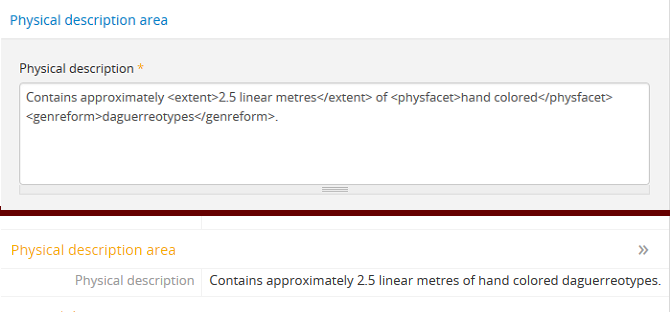
Publisher’s series area¶
Title proper of publisher’s series¶
Template field Title proper of publisher’s series
CSV Column radTitleProperOfPublishersSeries
RAD Rule “At the item level of description, transcribe a title proper of the publisher’s series as instructed in 1.1B1.” (RAD 1.6B)
EAD
<did>
<unittitle>
<bibseries>
<title encodinganalog="1.6B1">
Parallel titles of publisher’s series¶
Template field Parallel titles of publisher’s series
CSV Column radParallelTitlesOfPublishersSeries
RAD Rule “Transcribe parallel titles of a publisher’s series as instructed in 1.1D.” (RAD 1.6C1)
EAD
<did>
<unittitle>
<bibseries>
<title type="parallel" encodinganalog="1.6C1">
Other title information of publisher’s series¶
Template field Other title information of publisher’s series
CSV Column radOtherTitleInformationOfPublishersSeries
RAD Rule “Transcribe other title information of a publisher’s series as instructed in 1.1E and only if considered necessary for identifying the publisher’s series.” (RAD 1.6D1)
EAD
<did>
<unittitle>
<bibseries>
<title type="otherInfo" encodinganalog="1.6D1">
Statement of responsibility relating to publisher’s series¶
Template field Statement of responsibility relating to publisher’s series
CSV Column radStatementOfResponsibilityRelatingToPublishersSeries
RAD Rule “Transcribe explicit statements of responsibility appearing in conjunction with a formal title proper of a publisher’s series as instructed in 1.1F and only if considered necessary for identifying the publisher’s series.” (RAD 1.6E1)
EAD
<did>
<unittitle>
<bibseries>
<title type="statRep" encodinganalog="1.6E1">
Numbering within publisher’s series¶
Template field Numbering within publisher’s series
CSV Column radNumberingWithinPublishersSeries
RAD Rule “Give the numbering of the item within a publisher’s series in the terms given in the item.” (RAD 1.6F1)
EAD
<did>
<unittitle>
<bibseries>
<num encodinganalog="1.6F">
Note on publisher’s series¶
Template field Note on publisher’s series
CSV Column radPublishersSeriesNote
RAD Rule “Make notes on important details of publisher’s series that are not included in the Publisher’s series area, including variant series titles, incomplete series, and of numbers or letters that imply a series.” (RAD 1.8B10)
EAD
<odd type="bibSeries" encodinganalog="1.8B10">
Note
This field maps to the same EAD field as the field in Notes area below, Other notes- Publisher’s Series. Both notes refer to RAD 1.8B10.
Archival description area¶
Custodial history¶
Template field Custodial history
CSV Column archivalHistory
RAD Rule “Give the history of the custody of the unit being described, i.e., the successive transfers of ownership and custody or control of the material, along with the dates thereof, insofar as it can be ascertained.” (RAD 1.7C)
EAD
<custodhist encodinganalog="1.7C">
<p>
Scope and content¶
Template field Scope and content
CSV Column scopeAndContent
RAD Rule “At the fonds, series, and collection levels of description, and when necessary at the file and the item levels of description, indicate the level being described and give information about the scope and the internal structure of or arrangement of the records, and about their contents.” (RAD 1.7D)
“For the scope of the unit being described, give information about the functions and/or kinds of activities generating the records, the period of time, the subject matter, and the geographical area to which they pertain. For the content of the unit being described, give information about its internal structure by indicating its arrangement, organization, and/or enumerating its next lowest level of description. Summarize the principal documentary forms (e.g., reports, minutes, correspondence, drawings, speeches).” (RAD 1.7D1)
EAD
<scopecontent encodinganalog="1.7D">
<p>
Notes area¶
Physical condition¶
Template field Physical condition
CSV Column physicalCharacteristics
RAD Rule “Make notes on the physical condition of the unit being described if that condition materially affects the clarity or legibility of the records.” (RAD 1.8B9a)
EAD
<phystech encodinganalog="1.8B9a">
<p>
Immediate source of acquisition¶
Template field Immediate source of acquisition
CSV Column acquisition
RAD Rule “Record the donor or source (i.e., the immediate prior custodian) from whom the unit being described was acquired, and the date and method of acquisition, as well as the source/donor’s relationship to the material, if any or all of this information is not confidential. If the source/donor is unknown, record that information.” (RAD 1.8B12)
EAD
<acqinfo encodinganalog="1.8B12">
<p>
Arrangement¶
Template field Arrangement
CSV Column arrangement
RAD Rule “Make notes on the arrangement of the unit being described which contribute significantly to its understanding but cannot be put in the Scope and content (see 1.7D), e.g., about reorganisation(s) by the creator, arrangement by the archivist, changes in the classification scheme, or reconstitution of original order.” (RAD 1.8B13)
EAD
<arrangement encodinganalog="1.8B13">
<p>
Language of material¶
Template field Language of material
CSV Column language
RAD Rule “Record the language or languages of the unit being described, unless they are noted elsewhere or are apparent from other elements of the description.” RAD (1.8.B14).
EAD
<did>
<langmaterial encodinganalog="1.8B9a">
<language langcode="[ISO code]">
Note
Use a two-letter language code from ISO 639-1 when importing from CSV.
Script of material¶
Template field Script of material
CSV Column script
RAD Rule “[N]ote any distinctive alphabets or symbol systems employed.” RAD (1.8.B14)
EAD
<archdesc>
<did>
<langmaterial encodinganalog="1.8B9a">
<language scriptcode="[ISO code]">
Note
Use a four-letter script code from ISO 15924 when importing from CSV.
Language and script note¶
Template field Language and script note
CSV Column languageNote
RAD Rule “Record the language or languages of the unit being described, unless they are noted elsewhere or are apparent from other elements of the description. Also note any distinctive alphabets or symbol systems employed.” RAD (1.8.B14).
EAD
<did>
<langmaterial encodinganalog="1.8B9a">
Note
Not intended to duplicate information from language or script, above.
Location of originals¶
Template field Location of originals
CSV Column locationOfOriginals
RAD Rule “If the unit being described is a reproduction and the location of the original material is known, give that location. Give, in addition, any identifying numbers that may help in locating the original material in the cited location. If the originals are known to be no longer extant, give that information.” (RAD 1.8B15a)
EAD
<originalsloc encodinganalog="1.8B15a">
<p>
Availability of other formats¶
Template field Availability of other formats
CSV Column locationOfCopies
RAD Rule “If all or part of the unit being described is available (either in the institution or elsewhere) in another format(s), e.g., if the text being described is also available on microfilm; or if a film is also available on videocassette, make a note indicating the other format(s) in which the unit being described is available and its location, if that information is known. If only a part of the unit being described is available in another format(s), indicate which parts.” (RAD 1.8B15b)
EAD
<altformavail encodinganalog="1.8B15b">
<p>
Restrictions on access¶
Template field Restrictions on access
CSV Column accessConditions
RAD Rule “Give information about any restrictions placed on access to the unit (or parts of the unit) being described.” (RAD 1.8B16a)
EAD
<accessrestrict encodinganalog="1.8B16a">
<p>
See also
Terms governing use, reproduction, and publication¶
Template field Terms governing use, reproduction, and publication
CSV Column reproductionConditions
RAD Rule “Give information on legal or donor restrictions that may affect use or reproduction of the material.” (RAD 1.8B16c)
EAD
<userestrict encodinganalog="1.8B16c">
<p>
Finding aids¶
Template field Finding aids
CSV Column findingAids
RAD Rule “Give information regarding the existence of any finding aids. Include appropriate administrative and/or intellectual control tools over the material in existence at the time the unit is described, such as card catalogues, box lists, series lists, inventories, indexes, etc.” (RAD 1.8B17)
EAD
<otherfindaid encodinganalog="1.8B17">
<p>
Associated materials¶
Template field Associated materials
CSV Column relatedUnitsOfDescription
RAD Rule For associated material, “If records in another institution are associated with the unit being described by virtue of the fact that they share the same provenance, make a citation to the associated material at the fonds, series or collection level, or for discrete items, indicating its location if known.” (RAD 1.8B18).
For related material, “Indicate groups of records having some significant relationship by reason of shared responsibility or shared sphere of activity in one or more units of material external to the unit being described.” (RAD 1.8B20).
EAD
<relatedmaterial encodinganalog="1.8B18">
<p>
Accruals¶
Template field Accruals
CSV Column accruals
RAD Rule “When the unit being described is not yet complete, e.g., an open fonds or series, make a note explaining that further accruals are expected… If no further accruals are expected, indicate that the unit is considered closed.” (RAD 1.8B19)
EAD
<accruals encodinganalog="1.8B19">
<p>
Other notes - Accompanying material¶
Template field Other notes - Accompanying material
CSV Column radNoteAccompanyingMaterial
RAD Rule “Give details of accompanying material not mentioned in the Physical description area (see 1.5E).” (RAD 1.8B9c)
EAD
<odd type="material" encodinganalog="1.5E">
<p>
Other notes - Alpha-numeric designations¶
Template field Other notes - Alpha-numeric designations
CSV Column radNoteAlphaNumericDesignation
RAD Rule “If desirable, make a note of any important numbers borne by the unit being described other than publisher’s series numbers (see 1.6F) or standard numbers (see 1.9).” (RAD 1.8 B11)
EAD
<odd type="alphanumericDesignation" encodinganalog="1.8B11">
<p>
Other notes - Cast note¶
Template field Other notes - Cast note
CSV Column radNoteCast
RAD Rule “List featured players, performers, presenters or other on-screen personnel.” (Moving images - RAD 7.8B5b)
EAD
Note
At this time, the RAD Cast note field in AtoM has not been mapped to the EAD import/export.
Other notes - Conservation¶
Template field Other notes - Conservation
CSV Column radNoteConservation
RAD Rule “If the unit being described has received any specific conservation treatment, e.g., if repair work has been done on it, briefly indicate the nature of the work.” (RAD 1.8B9b)
EAD
<odd type="conservation" encodinganalog="1.8B9b">
<p>
Other notes - Credits note¶
Template field Other notes - Credits note
CSV Column radNoteCredits
RAD Rule “List persons (other than the cast) who have contributed to the artistic and/or technical production of a moving image document. Preface each name or group of names with a statement of function.” (Moving images - RAD 7.8B5a)
EAD
Note
At this time, the RAD Credits note field in AtoM has not been mapped to the EAD import/export.
Other notes - Edition¶
Template field Other notes - Edition
CSV Column radNoteEdition
RAD Rule “Make notes relating to the edition being described or of the relationship of the unit being described to other editions.” (RAD 1.8B7)
EAD
<odd type="edition" encodinganalog="1.8B7">
<p>
Other notes - Physical description¶
Template field Other notes - Physical description
CSV Column radNotePhysicalDescription
RAD Rule “Make notes relating to the physical description of the unit being described.” (RAD 1.8B9)
EAD
<odd type="physDesc" encodinganalog="1.8B9">
<p>
Other notes - Publisher’s series¶
Template field Other notes - Publisher’s series
CSV Column radPublishersSeriesNote
RAD Rule “Make notes on important details of publisher’s series that are not included in the Publisher’s series area, including variant series titles, incomplete series, and of numbers or letters that imply a series.” (RAD 1.8B10)
EAD
<odd type="bibSeries" encodinganalog="1.8B10">
<p>
Note
This column maps to the same EAD field as the column above, Note on Publishers Series. Both notes refer to RAD 1.8B10.
Other notes- Rights¶
Template field Other notes- Rights
CSV Column radNoteRights
RAD Rule “Indicate the copyright status, literary rights, patents or any other rights pertaining to the unit being described.” (RAD 1.8B16b)
EAD
<odd type="rights" encodinganalog="1.8B16b">
<p>
Other notes- Signatures note¶
Template field Other notes- Signatures note
CSV Column radNoteSignatures
RAD Rule “Make notes on signatures, inscriptions, or monograms, etc., which appear on the unit being described. Indicate where such signatures and inscriptions appear.”(RAD 3.8B6)
See also: RAD 4.8B7 (Graphic materials); RAD 5.8B6 (Cartographic materials); RAD 6.8B6 (Architecture and technical drawings); RAD 11.8B7 (Objects); and RAD 12.8B7 (Philatelic records).
EAD
Note
At this time, the RAD Signatures note field in AtoM has not been mapped to the EAD import/export.
Other notes - General note¶
Template field Other notes - General note
CSV Column radNoteGeneral
RAD Rule “Use this note to record any other descriptive information considered important but not falling within the definitions of the other notes. (RAD 1.8B21).
EAD
<odd type="general" encodinganalog="1.8B21">
<p>
Standard number area¶
Standard number¶
Template field Standard number
CSV Column radStandardNumber
RAD Rule “Give the International Standard Book Number (ISBN), International Standard Serial Number (ISSN), or any other internationally agreed standard number for the item being described. Give such numbers with the agreed abbreviation and with the standard spacing or hyphenation.” (RAD 1.9B1)
EAD
<did>
<unitid type="standard" encodinganalog="1.9B1">
Access points¶
Subject access points¶
Template field Subject access points
CSV Column subjectAccessPoints
RAD Rule “Search for an existing term in the Subjects taxonomy by typing the first few characters of the term. Alternatively, type a new term to create and link to a new subject term.”
EAD
<controlaccess>
<subject>
Place access points¶
Template field Place access points
CSV Column placeAccessPoints
RAD Rule “Search for an existing term in the Places taxonomy by typing the first few characters of the term name. Alternatively, type a new term to create and link to a new place term.”
EAD
<controlaccess>
<geogname>
Genre access points¶
Template field Genre access points
CSV Column genreAccessPoints
Note
The Genre taxonomy access points were added to AtoM in version 2.2. Currently the access point field is only available on the RAD template, though we hope to make it available on the ISAD and DACS in the future. At this time, it has not been added to the CSV import templates.
RAD Rule N/A
EAD
<controlaccess>
<genreform>
Note
The Genre taxonomy comes pre-populated in AtoM with genre/documentary form terms. All 45 terms included have been taken from the US Library of Congress’ “Basic Genre Terms for Cultural Heritage Materials,” available at: http://memory.loc.gov/ammem/techdocs/genre.html. All terms can be edited or deleted by users, and new ones can be added. When using the Genre access point field in the RAD template, new values added in this field will create terms in the Genre taxonomy where those do not already exist.
Tip
The Genre terms can be used as a facet in the Browse and search pages. The label on the facet can be customized by an administrator via Admin > Settings > User interface labels. See: User interface labels.
Name access points¶
Template field Name access points
CSV Column nameAccessPoints
RAD Rule “Choose provenance, author and other non-subject access points from the archival description, as appropriate. All access points must be apparent from the archival description to which they relate.” (RAD 21.0B) The values in this field are drawn from the Authorized form of name field in authority records. Search for an existing name by typing the first few characters of the name. Alternatively, type a new name to create and link to a new authority record.
EAD
If the entity type of the actor is not defined as either a person, family, or corporate body:
<controlaccess>
<name role="subject">
Note
This is the default export EAD when an Entity type has not been set for the
actor on the related authority record. The final EAD element can be
more precise, if the user has entered an Entity type on the related
authority record. When the Entity type is set to Person, the EAD
will export using <persname> instead of <name>; when set to
Family, the EAD will export using <famname> instead of <name>;
and when set to Organization, the EAD will export using <corpname>
instead of <name>. The <name> element is the default when no
entity type is set. For more information on authority records and the ISAAR
standard upon which the authority record template is based, see:
Authority records and International Standard Archival Authority Record for Corporate Bodies, Persons, and Families.
This field is an auto-complete - the drop-down will suggest existing authority records as you type. Values in this column/field that are entered instead of selected from the drop-down will create new authority records.
Control area¶
For more information on the use of fields in the control area, see control area.
Description record identifier¶
Template field Description record identifier
CSV Column descriptionIdentifier
RAD Rule “Record a unique description identifier in accordance with local and/or national conventions. If the description is to be used internationally, record the code of the country in which the description was created in accordance with the latest version of ISO 3166- Codes for the representation of names of countries. Where the creator of the description is an international organisation, give the organisational identifier in place of the country code.”
EAD
<odd type="descriptionIdentifier">
<p>
Institution identifier¶
Template field Institution identifier
CSV Column institutionIdentifier
RAD Rule “Record the full, authorised form of name(s) of the agency(ies) responsible for creating, modifying, or disseminating the description, or, alternatively, record a code for the agency in accordance with the national or international agency code standard.”
EAD
<odd type="institutionIdentifier">
<p>
Rules or conventions¶
Template field Rules or conventions
CSV Column rules
RAD Rule “Record the international, national, and/or local rules or conventions followed in preparing the description.”
EAD
<eadheader>
<profiledesc>
<descrules encodinganalog="3.7.2">
Status¶
Template field Status
CSV Column descriptionStatus
RAD Rule “Record the current status of the description, indicating whether it is a draft, finalized, and/or revised or deleted.”
EAD
<odd type="statusDescription">
<p>
Note
AtoM uses a taxonomy to determine the value of this field. The default terms are Final, Revised and Draft, but can be edited through the Manage taxonomy screen.
Level of detail¶
Template field Level of detail
CSV Column levelOfDetail
RAD Rule “Record whether the description consists of a minimal, partial, or full level of detail in accordance with relevant international and/or national guidelines and/or rules.”
EAD
<odd type="levelOfDetail">
<p>
Note
AtoM uses a taxonomy to determine the value of this field. The default terms are Full, Partial and Minimal, but can be edited through the Manage taxonomy screen.
Dates of creation, revision and deletion¶
Template field Dates of creation, revision and deletion
CSV Column revisionHistory
RAD Rule “Record the date(s) the entry was prepared and/or revised.”
EAD
<processinfo>
<date>
Note
This is a free text field, allowing users to also write narrative notes about the revision history of the description.
Language of description¶
Template field Language of description
CSV Column languageOfDescription
RAD Rule “Indicate the language(s) used to create the description of the archival material.”
EAD
<eadheader>
<profiledesc>
<language>
<language langcode="[ISO code]">
Note
In CSV import, use a two-letter language code from ISO 639-1 . When entering data manually, AtoM will offer an autocomplete drop-down list as you type, which will be generated as a three-letter language code in the EAD.
Script of description¶
Template field Script of description
CSV Column scriptOfDescription
RAD Rule “Indicate the script(s) used to create the description of the archival material.”
EAD
<eadheader>
<profiledesc>
<language>
<language scriptcode="[ISO code]">
Note
In CSV import, use a four-letter script code from ISO 15924. When entering data manually, AtoM will offer an autocomplete drop-down list as you type, which will be generated as a four-letter script code in the EAD.
Sources¶
Template field Sources
CSV Column sources
RAD Rule “Record citations for any external sources used in the archival description (such as the Scope and Content, Custodial History, or Notes fields).”
EAD
<did>
<note type="sourcesDescription">
<p>
Note
If there are sources to cite used used in a biographical sketch or administrative history, record these in the sources field for the authority record.
Rights area¶
This area of the description allows users to enter a rights record compliant with PREMIS. These fields are separate from the RAD rights notes, above, and editing one area does not effect the other. Rights records cannot be imported with descriptions via CSV.
At present, the PREMIS rights added to a record are only visible to authenticated (i.e. logged in) users.
For more information, see Rights, especially Add rights to an Archival description, and Preservation Metadata: Implementation Strategies v2.2 (PREMIS).
Administration area¶
Display standard¶
Template field Display standard
CSV column N/A
RAD Rule N/A
EAD N/A
Note
This fields allows the user to choose a different display standard from the default template for the shown archival description only, with the option to also change the display standard for all existing children of the description. See: Change the display standard.
Publication status¶
Template field Publication status is available under the More tab located on the object view screen.
CSV column publicationsStatus
RAD Rule N/A
EAD
<odd type="publicationStatus">
<p>
Note
The publication status refers to the public visibility of a description for unauthenticated (e.g. not logged in) users. The default terms available are “Published” (i.e. visible to public users), and “Draft” (e.g. not visible to public users). See: Publish an archival description.
In the Global Site Settings, if the default publication status is set to draft, all imported descriptions will be set to draft and the EAD file will have the value “draft” in the <odd type=”publicationStatus”> tag.


